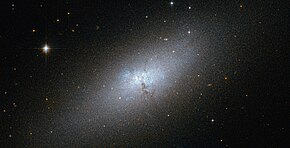NGC 5253
| NGC5253 | |
|---|---|
 NGC 5253 is one of the nearest of the known Blue Compact Dwarf (BCD) galaxies[1] | |
| Observation data (J2000epoch) | |
| Constellation | Centaurus |
| Right ascension | 13h39m55.9631s[2] |
| Declination | −31° 38′ 24.388″[2] |
| Redshift | 407 ± 3 km/s[2] |
| Distance | 10.9 ± 0.6Mly(3.33 ± 0.17Mpc)[3] |
| Apparent magnitude(V) | 10.9[2] |
| Characteristics | |
| Type | Im pec[2] |
| Apparent size(V) | 5.0′× 1.9′[2] |
| Other designations | |
| UGCA 369,[2]PGC48334,[2]Haro 10[2] | |
NGC 5253is anirregular galaxyin theconstellationCentaurus.It was discovered byWilliam Herschelon 15 March 1787.[4]
Properties[edit]
NGC 5253 is located within the M83 Subgroup of theCentaurus A/M83 Group,a relatively nearbygalaxy groupthat includes theradio galaxyCentaurus Aand thespiral galaxyM83(the Southern Pinwheel Galaxy). NGC 5253 is considered a dwarfstarburst galaxy[5]and also ablue compact galaxy.[6]
Twosupernovaehave been observed in NGC 5253.SN 1895B(type unknown, mag. 8) was discovered on 7 July 1895.[7]Supernova SN 1972E(type Ia,mag. 8.5),[8]the second-brightest recent supernova visible from Earth, was discovered on 6 May 1972. With a peak apparent magnitude of 8.5, the only brighter supernova observed in the 20th century wasSN 1987A.[9][10]
Contents[edit]
NGC 5253 contains a giant dust cloud hiding a cluster (believed to be asuper star cluster) of more than one million stars, among them up to 7,000O-type stars.The cluster is 3 million years old and has a total luminosity of more than one billion suns. It is the site of efficientstar formation,with a rate at least 10 times higher than comparable regions in theMilky Way.[11][12]
References[edit]
- ^"A Peculiar Compact Blue Dwarf Galaxy".ESA/Hubble Picture of the Week.Retrieved26 November2012.
- ^abcdefghi"NASA/IPAC Extragalactic Database".Results for NGC 5253.Retrieved2006-11-10.
- ^Ferrarese, Laura; Ford, Holland C.; Huchra, John; Kennicutt, Robert C. Jr.; et al. (2000). "A Database of Cepheid Distance Moduli and Tip of the Red Giant Branch, Globular Cluster Luminosity Function, Planetary Nebula Luminosity Function, and Surface Brightness Fluctuation Data Useful for Distance Determinations".The Astrophysical Journal Supplement Series.128(2): 431–459.arXiv:astro-ph/9910501.Bibcode:2000ApJS..128..431F.doi:10.1086/313391.S2CID121612286.
- ^The scientific papers of Sir William HerschelbyJ. L. E. Dreyer.Royal Astronomical Society London 1912.
- ^Jordan Zastrow; M.S. Oey; Sylvain Veilleux; Michael McDonald; Crystal L. Martin (2011). "An Ionization Cone in the Dwarf Starburst Galaxy NGC 5253".The Astrophysical Journal.741(1): (page needed).arXiv:1109.6360.Bibcode:2011ApJ...741L..17Z.doi:10.1088/2041-8205/741/1/L17.S2CID17071524.
- ^"Hubble Spots a Peculiar Compact Blue Dwarf Galaxy".NASA. 30 November 2012. Archived fromthe originalon 11 September 2014.
- ^Kowal, C. T.; Sargent, W. L. W. (Nov 1971)."Supernovae discovered since 1885".Astronomical Journal.76:756–764.Bibcode:1971AJ.....76..756K.doi:10.1086/111193.
- ^Transient Name Server entry for SN 1972E.Retrieved 20 May 2024.
- ^I. D. Karachentsev; M. E. Sharina; A. E. Dolphin; E. K. Grebel; et al. (2002)."New distances to galaxies in the Centaurus A group".Astronomy and Astrophysics.385(1): 21–31.Bibcode:2002A&A...385...21K.doi:10.1051/0004-6361:20020042.
- ^I. D. Karachentsev (2005). "The Local Group and Other Neighboring Galaxy Groups".Astronomical Journal.129(1): 178–188.arXiv:astro-ph/0410065.Bibcode:2005AJ....129..178K.doi:10.1086/426368.S2CID119385141.
- ^Stuart Wolpert (March 18, 2015)."More than a million stars are forming in a mysterious dusty gas cloud in a nearby galaxy"(Press release).UCLA.Archived fromthe originalon March 19, 2015.
- ^J. L. Turner; S. C. Beck; D. J. Benford; S. M. Consiglio; et al. (2015). "Highly efficient star formation in NGC 5253 possibly from stream-fed accretion".Nature.519(7543): 331–333.arXiv:1503.05254.Bibcode:2015Natur.519..331T.doi:10.1038/nature14218.PMID25788096.S2CID4396346.
External links[edit]
 Media related toNGC 5253at Wikimedia Commons
Media related toNGC 5253at Wikimedia Commons
